Cultural Autobiography Report: Comparing Two Diverse Cultures
VerifiedAdded on 2023/01/16
|13
|3587
|65
Report
AI Summary
This report presents a comparative analysis of two cultural autobiographies, examining the cultural backgrounds, values, and beliefs of two individuals. The report begins with an introduction to the concept of culture and cultural autobiographies, followed by a detailed comparison of the two autobiographies, highlighting similarities and differences in areas such as emotional quotient, individualism, gender roles, and religious inclination. The main body of the report further explores the application of various cultural frameworks, including Edward T. Hall's high and low context, Fons Trompenaars and Charles Hampden-Turner's seven dimensions of culture, and Geert Hofstede's cultural dimensions, to analyze and interpret the cultural differences observed. The report concludes by summarizing the key findings and emphasizing the importance of understanding cultural diversity. The analysis provides insights into the complex interplay of cultural factors and their impact on individual behavior and societal norms.

CULTURAL
AUTOBIOGRAPHY
AUTOBIOGRAPHY
Paraphrase This Document
Need a fresh take? Get an instant paraphrase of this document with our AI Paraphraser
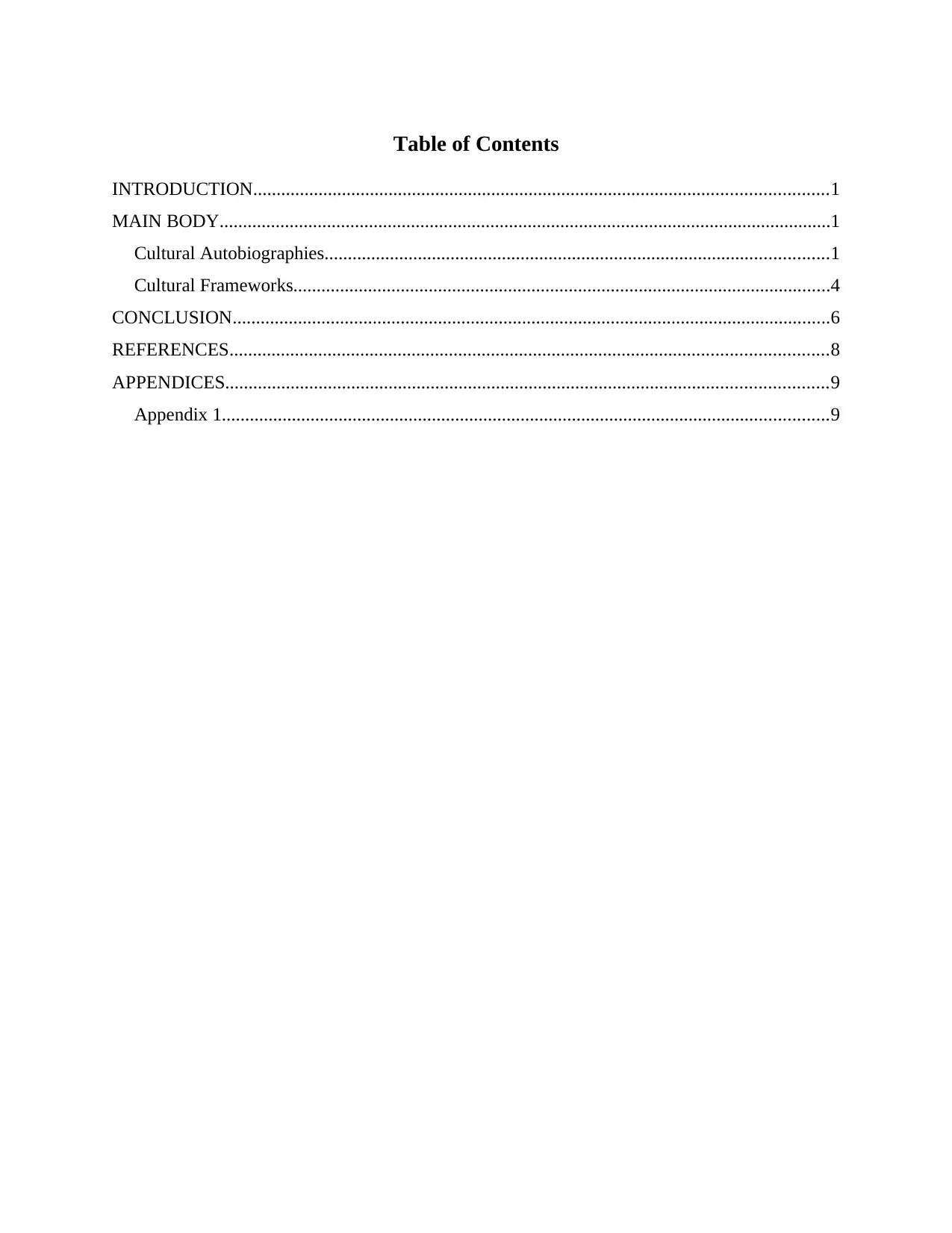
Table of Contents
INTRODUCTION...........................................................................................................................1
MAIN BODY...................................................................................................................................1
Cultural Autobiographies............................................................................................................1
Cultural Frameworks...................................................................................................................4
CONCLUSION................................................................................................................................6
REFERENCES................................................................................................................................8
APPENDICES.................................................................................................................................9
Appendix 1..................................................................................................................................9
INTRODUCTION...........................................................................................................................1
MAIN BODY...................................................................................................................................1
Cultural Autobiographies............................................................................................................1
Cultural Frameworks...................................................................................................................4
CONCLUSION................................................................................................................................6
REFERENCES................................................................................................................................8
APPENDICES.................................................................................................................................9
Appendix 1..................................................................................................................................9
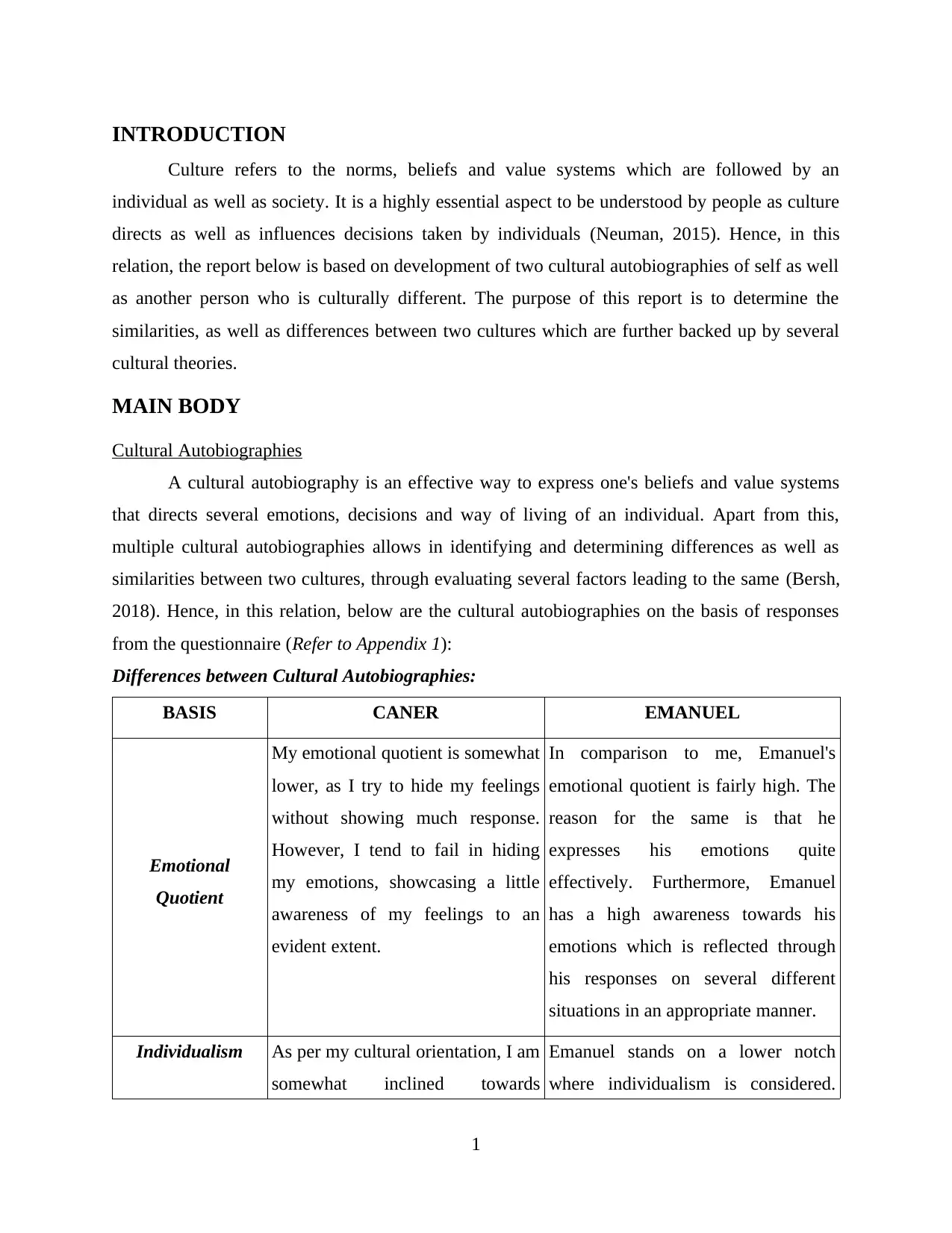
INTRODUCTION
Culture refers to the norms, beliefs and value systems which are followed by an
individual as well as society. It is a highly essential aspect to be understood by people as culture
directs as well as influences decisions taken by individuals (Neuman, 2015). Hence, in this
relation, the report below is based on development of two cultural autobiographies of self as well
as another person who is culturally different. The purpose of this report is to determine the
similarities, as well as differences between two cultures which are further backed up by several
cultural theories.
MAIN BODY
Cultural Autobiographies
A cultural autobiography is an effective way to express one's beliefs and value systems
that directs several emotions, decisions and way of living of an individual. Apart from this,
multiple cultural autobiographies allows in identifying and determining differences as well as
similarities between two cultures, through evaluating several factors leading to the same (Bersh,
2018). Hence, in this relation, below are the cultural autobiographies on the basis of responses
from the questionnaire (Refer to Appendix 1):
Differences between Cultural Autobiographies:
BASIS CANER EMANUEL
Emotional
Quotient
My emotional quotient is somewhat
lower, as I try to hide my feelings
without showing much response.
However, I tend to fail in hiding
my emotions, showcasing a little
awareness of my feelings to an
evident extent.
In comparison to me, Emanuel's
emotional quotient is fairly high. The
reason for the same is that he
expresses his emotions quite
effectively. Furthermore, Emanuel
has a high awareness towards his
emotions which is reflected through
his responses on several different
situations in an appropriate manner.
Individualism As per my cultural orientation, I am
somewhat inclined towards
Emanuel stands on a lower notch
where individualism is considered.
1
Culture refers to the norms, beliefs and value systems which are followed by an
individual as well as society. It is a highly essential aspect to be understood by people as culture
directs as well as influences decisions taken by individuals (Neuman, 2015). Hence, in this
relation, the report below is based on development of two cultural autobiographies of self as well
as another person who is culturally different. The purpose of this report is to determine the
similarities, as well as differences between two cultures which are further backed up by several
cultural theories.
MAIN BODY
Cultural Autobiographies
A cultural autobiography is an effective way to express one's beliefs and value systems
that directs several emotions, decisions and way of living of an individual. Apart from this,
multiple cultural autobiographies allows in identifying and determining differences as well as
similarities between two cultures, through evaluating several factors leading to the same (Bersh,
2018). Hence, in this relation, below are the cultural autobiographies on the basis of responses
from the questionnaire (Refer to Appendix 1):
Differences between Cultural Autobiographies:
BASIS CANER EMANUEL
Emotional
Quotient
My emotional quotient is somewhat
lower, as I try to hide my feelings
without showing much response.
However, I tend to fail in hiding
my emotions, showcasing a little
awareness of my feelings to an
evident extent.
In comparison to me, Emanuel's
emotional quotient is fairly high. The
reason for the same is that he
expresses his emotions quite
effectively. Furthermore, Emanuel
has a high awareness towards his
emotions which is reflected through
his responses on several different
situations in an appropriate manner.
Individualism As per my cultural orientation, I am
somewhat inclined towards
Emanuel stands on a lower notch
where individualism is considered.
1
⊘ This is a preview!⊘
Do you want full access?
Subscribe today to unlock all pages.

Trusted by 1+ million students worldwide
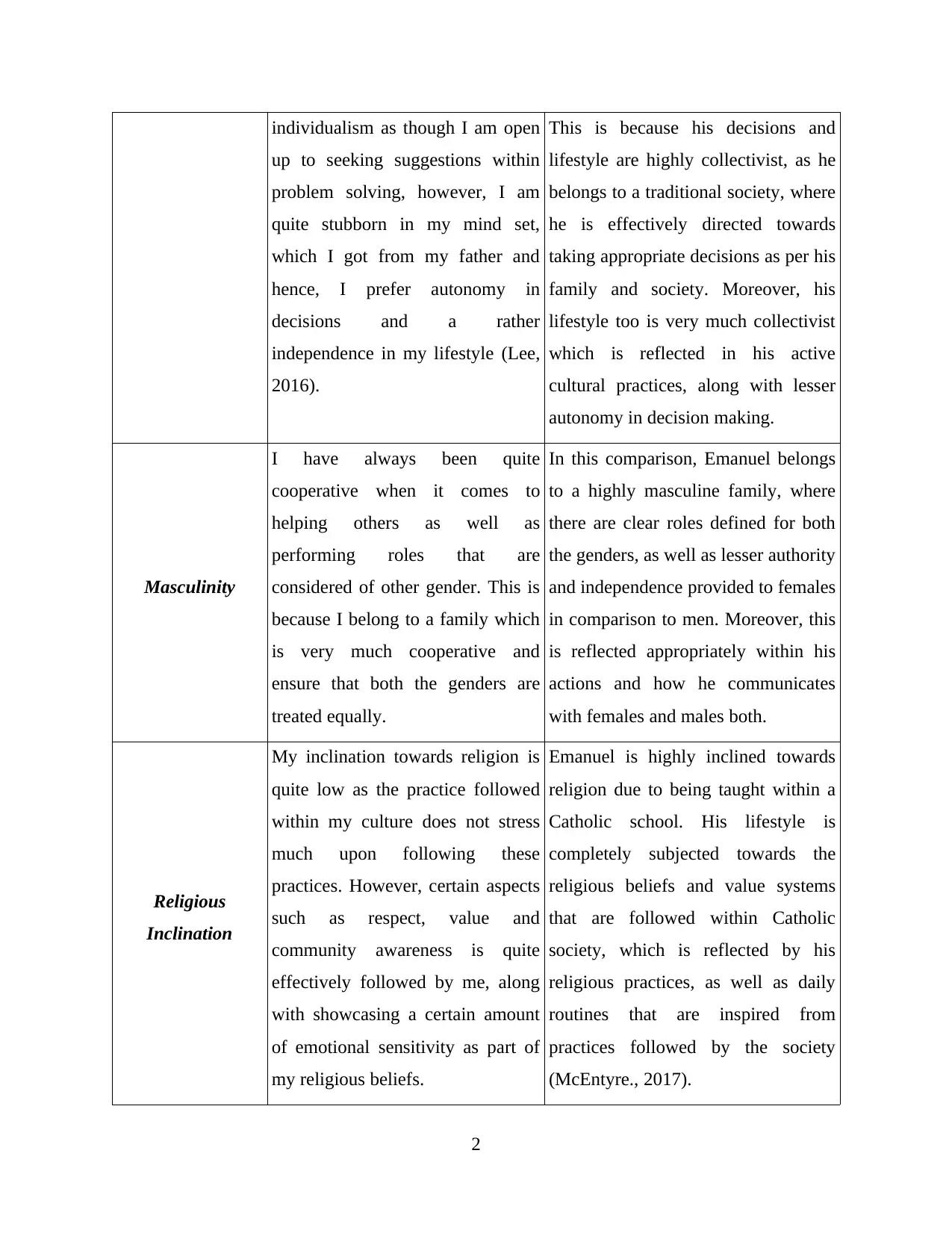
individualism as though I am open
up to seeking suggestions within
problem solving, however, I am
quite stubborn in my mind set,
which I got from my father and
hence, I prefer autonomy in
decisions and a rather
independence in my lifestyle (Lee,
2016).
This is because his decisions and
lifestyle are highly collectivist, as he
belongs to a traditional society, where
he is effectively directed towards
taking appropriate decisions as per his
family and society. Moreover, his
lifestyle too is very much collectivist
which is reflected in his active
cultural practices, along with lesser
autonomy in decision making.
Masculinity
I have always been quite
cooperative when it comes to
helping others as well as
performing roles that are
considered of other gender. This is
because I belong to a family which
is very much cooperative and
ensure that both the genders are
treated equally.
In this comparison, Emanuel belongs
to a highly masculine family, where
there are clear roles defined for both
the genders, as well as lesser authority
and independence provided to females
in comparison to men. Moreover, this
is reflected appropriately within his
actions and how he communicates
with females and males both.
Religious
Inclination
My inclination towards religion is
quite low as the practice followed
within my culture does not stress
much upon following these
practices. However, certain aspects
such as respect, value and
community awareness is quite
effectively followed by me, along
with showcasing a certain amount
of emotional sensitivity as part of
my religious beliefs.
Emanuel is highly inclined towards
religion due to being taught within a
Catholic school. His lifestyle is
completely subjected towards the
religious beliefs and value systems
that are followed within Catholic
society, which is reflected by his
religious practices, as well as daily
routines that are inspired from
practices followed by the society
(McEntyre., 2017).
2
up to seeking suggestions within
problem solving, however, I am
quite stubborn in my mind set,
which I got from my father and
hence, I prefer autonomy in
decisions and a rather
independence in my lifestyle (Lee,
2016).
This is because his decisions and
lifestyle are highly collectivist, as he
belongs to a traditional society, where
he is effectively directed towards
taking appropriate decisions as per his
family and society. Moreover, his
lifestyle too is very much collectivist
which is reflected in his active
cultural practices, along with lesser
autonomy in decision making.
Masculinity
I have always been quite
cooperative when it comes to
helping others as well as
performing roles that are
considered of other gender. This is
because I belong to a family which
is very much cooperative and
ensure that both the genders are
treated equally.
In this comparison, Emanuel belongs
to a highly masculine family, where
there are clear roles defined for both
the genders, as well as lesser authority
and independence provided to females
in comparison to men. Moreover, this
is reflected appropriately within his
actions and how he communicates
with females and males both.
Religious
Inclination
My inclination towards religion is
quite low as the practice followed
within my culture does not stress
much upon following these
practices. However, certain aspects
such as respect, value and
community awareness is quite
effectively followed by me, along
with showcasing a certain amount
of emotional sensitivity as part of
my religious beliefs.
Emanuel is highly inclined towards
religion due to being taught within a
Catholic school. His lifestyle is
completely subjected towards the
religious beliefs and value systems
that are followed within Catholic
society, which is reflected by his
religious practices, as well as daily
routines that are inspired from
practices followed by the society
(McEntyre., 2017).
2
Paraphrase This Document
Need a fresh take? Get an instant paraphrase of this document with our AI Paraphraser
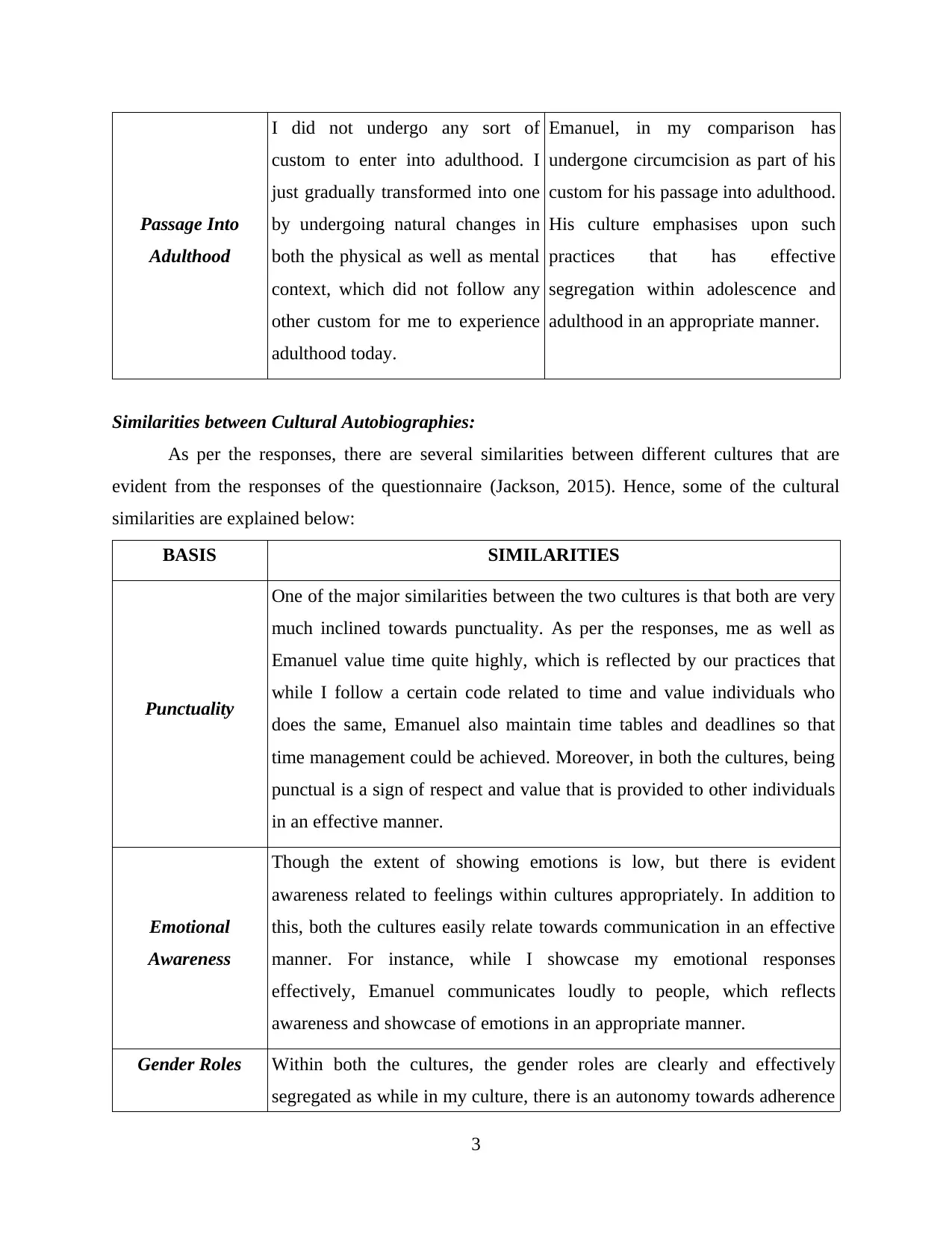
Passage Into
Adulthood
I did not undergo any sort of
custom to enter into adulthood. I
just gradually transformed into one
by undergoing natural changes in
both the physical as well as mental
context, which did not follow any
other custom for me to experience
adulthood today.
Emanuel, in my comparison has
undergone circumcision as part of his
custom for his passage into adulthood.
His culture emphasises upon such
practices that has effective
segregation within adolescence and
adulthood in an appropriate manner.
Similarities between Cultural Autobiographies:
As per the responses, there are several similarities between different cultures that are
evident from the responses of the questionnaire (Jackson, 2015). Hence, some of the cultural
similarities are explained below:
BASIS SIMILARITIES
Punctuality
One of the major similarities between the two cultures is that both are very
much inclined towards punctuality. As per the responses, me as well as
Emanuel value time quite highly, which is reflected by our practices that
while I follow a certain code related to time and value individuals who
does the same, Emanuel also maintain time tables and deadlines so that
time management could be achieved. Moreover, in both the cultures, being
punctual is a sign of respect and value that is provided to other individuals
in an effective manner.
Emotional
Awareness
Though the extent of showing emotions is low, but there is evident
awareness related to feelings within cultures appropriately. In addition to
this, both the cultures easily relate towards communication in an effective
manner. For instance, while I showcase my emotional responses
effectively, Emanuel communicates loudly to people, which reflects
awareness and showcase of emotions in an appropriate manner.
Gender Roles Within both the cultures, the gender roles are clearly and effectively
segregated as while in my culture, there is an autonomy towards adherence
3
Adulthood
I did not undergo any sort of
custom to enter into adulthood. I
just gradually transformed into one
by undergoing natural changes in
both the physical as well as mental
context, which did not follow any
other custom for me to experience
adulthood today.
Emanuel, in my comparison has
undergone circumcision as part of his
custom for his passage into adulthood.
His culture emphasises upon such
practices that has effective
segregation within adolescence and
adulthood in an appropriate manner.
Similarities between Cultural Autobiographies:
As per the responses, there are several similarities between different cultures that are
evident from the responses of the questionnaire (Jackson, 2015). Hence, some of the cultural
similarities are explained below:
BASIS SIMILARITIES
Punctuality
One of the major similarities between the two cultures is that both are very
much inclined towards punctuality. As per the responses, me as well as
Emanuel value time quite highly, which is reflected by our practices that
while I follow a certain code related to time and value individuals who
does the same, Emanuel also maintain time tables and deadlines so that
time management could be achieved. Moreover, in both the cultures, being
punctual is a sign of respect and value that is provided to other individuals
in an effective manner.
Emotional
Awareness
Though the extent of showing emotions is low, but there is evident
awareness related to feelings within cultures appropriately. In addition to
this, both the cultures easily relate towards communication in an effective
manner. For instance, while I showcase my emotional responses
effectively, Emanuel communicates loudly to people, which reflects
awareness and showcase of emotions in an appropriate manner.
Gender Roles Within both the cultures, the gender roles are clearly and effectively
segregated as while in my culture, there is an autonomy towards adherence
3
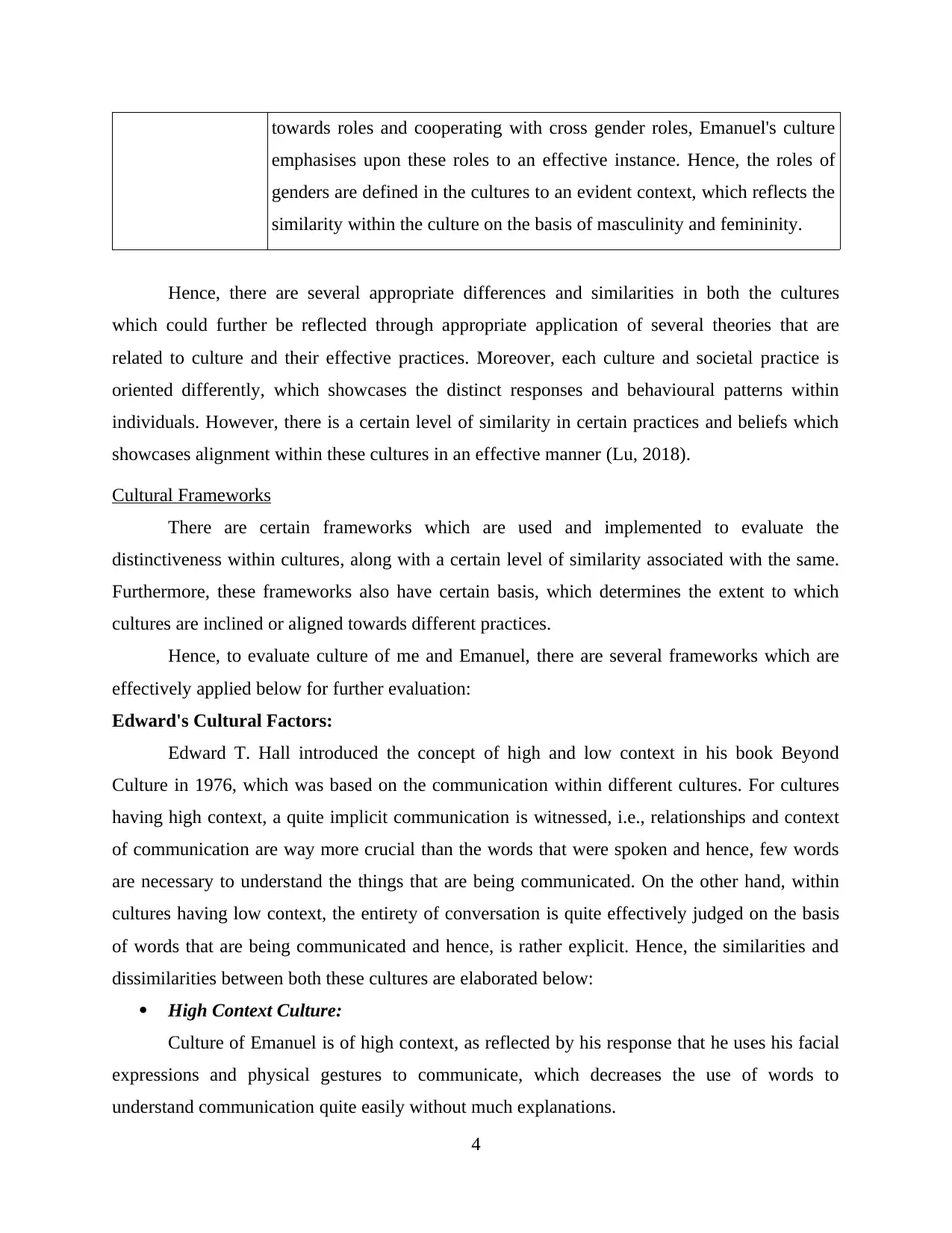
towards roles and cooperating with cross gender roles, Emanuel's culture
emphasises upon these roles to an effective instance. Hence, the roles of
genders are defined in the cultures to an evident context, which reflects the
similarity within the culture on the basis of masculinity and femininity.
Hence, there are several appropriate differences and similarities in both the cultures
which could further be reflected through appropriate application of several theories that are
related to culture and their effective practices. Moreover, each culture and societal practice is
oriented differently, which showcases the distinct responses and behavioural patterns within
individuals. However, there is a certain level of similarity in certain practices and beliefs which
showcases alignment within these cultures in an effective manner (Lu, 2018).
Cultural Frameworks
There are certain frameworks which are used and implemented to evaluate the
distinctiveness within cultures, along with a certain level of similarity associated with the same.
Furthermore, these frameworks also have certain basis, which determines the extent to which
cultures are inclined or aligned towards different practices.
Hence, to evaluate culture of me and Emanuel, there are several frameworks which are
effectively applied below for further evaluation:
Edward's Cultural Factors:
Edward T. Hall introduced the concept of high and low context in his book Beyond
Culture in 1976, which was based on the communication within different cultures. For cultures
having high context, a quite implicit communication is witnessed, i.e., relationships and context
of communication are way more crucial than the words that were spoken and hence, few words
are necessary to understand the things that are being communicated. On the other hand, within
cultures having low context, the entirety of conversation is quite effectively judged on the basis
of words that are being communicated and hence, is rather explicit. Hence, the similarities and
dissimilarities between both these cultures are elaborated below:
High Context Culture:
Culture of Emanuel is of high context, as reflected by his response that he uses his facial
expressions and physical gestures to communicate, which decreases the use of words to
understand communication quite easily without much explanations.
4
emphasises upon these roles to an effective instance. Hence, the roles of
genders are defined in the cultures to an evident context, which reflects the
similarity within the culture on the basis of masculinity and femininity.
Hence, there are several appropriate differences and similarities in both the cultures
which could further be reflected through appropriate application of several theories that are
related to culture and their effective practices. Moreover, each culture and societal practice is
oriented differently, which showcases the distinct responses and behavioural patterns within
individuals. However, there is a certain level of similarity in certain practices and beliefs which
showcases alignment within these cultures in an effective manner (Lu, 2018).
Cultural Frameworks
There are certain frameworks which are used and implemented to evaluate the
distinctiveness within cultures, along with a certain level of similarity associated with the same.
Furthermore, these frameworks also have certain basis, which determines the extent to which
cultures are inclined or aligned towards different practices.
Hence, to evaluate culture of me and Emanuel, there are several frameworks which are
effectively applied below for further evaluation:
Edward's Cultural Factors:
Edward T. Hall introduced the concept of high and low context in his book Beyond
Culture in 1976, which was based on the communication within different cultures. For cultures
having high context, a quite implicit communication is witnessed, i.e., relationships and context
of communication are way more crucial than the words that were spoken and hence, few words
are necessary to understand the things that are being communicated. On the other hand, within
cultures having low context, the entirety of conversation is quite effectively judged on the basis
of words that are being communicated and hence, is rather explicit. Hence, the similarities and
dissimilarities between both these cultures are elaborated below:
High Context Culture:
Culture of Emanuel is of high context, as reflected by his response that he uses his facial
expressions and physical gestures to communicate, which decreases the use of words to
understand communication quite easily without much explanations.
4
⊘ This is a preview!⊘
Do you want full access?
Subscribe today to unlock all pages.

Trusted by 1+ million students worldwide
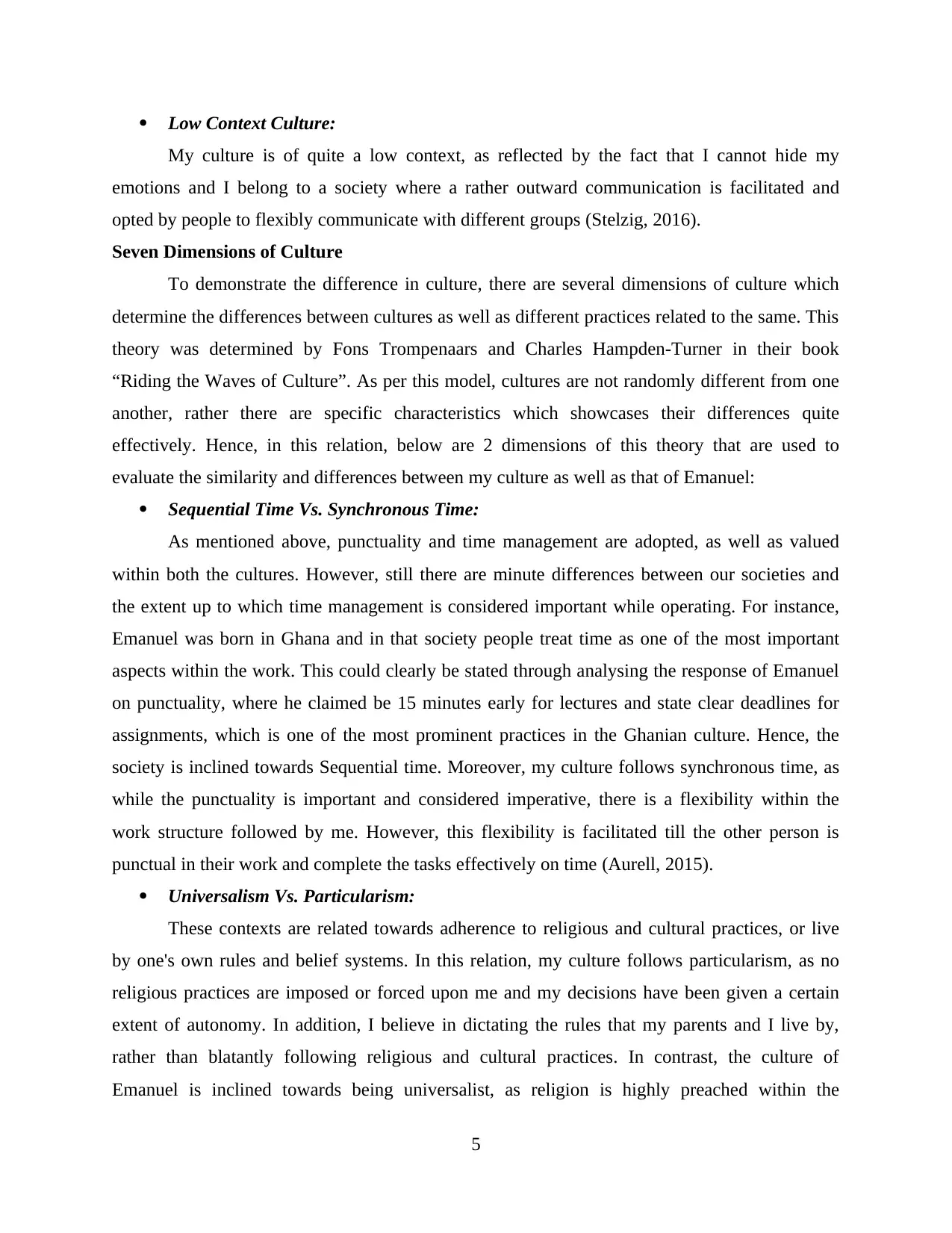
Low Context Culture:
My culture is of quite a low context, as reflected by the fact that I cannot hide my
emotions and I belong to a society where a rather outward communication is facilitated and
opted by people to flexibly communicate with different groups (Stelzig, 2016).
Seven Dimensions of Culture
To demonstrate the difference in culture, there are several dimensions of culture which
determine the differences between cultures as well as different practices related to the same. This
theory was determined by Fons Trompenaars and Charles Hampden-Turner in their book
“Riding the Waves of Culture”. As per this model, cultures are not randomly different from one
another, rather there are specific characteristics which showcases their differences quite
effectively. Hence, in this relation, below are 2 dimensions of this theory that are used to
evaluate the similarity and differences between my culture as well as that of Emanuel:
Sequential Time Vs. Synchronous Time:
As mentioned above, punctuality and time management are adopted, as well as valued
within both the cultures. However, still there are minute differences between our societies and
the extent up to which time management is considered important while operating. For instance,
Emanuel was born in Ghana and in that society people treat time as one of the most important
aspects within the work. This could clearly be stated through analysing the response of Emanuel
on punctuality, where he claimed be 15 minutes early for lectures and state clear deadlines for
assignments, which is one of the most prominent practices in the Ghanian culture. Hence, the
society is inclined towards Sequential time. Moreover, my culture follows synchronous time, as
while the punctuality is important and considered imperative, there is a flexibility within the
work structure followed by me. However, this flexibility is facilitated till the other person is
punctual in their work and complete the tasks effectively on time (Aurell, 2015).
Universalism Vs. Particularism:
These contexts are related towards adherence to religious and cultural practices, or live
by one's own rules and belief systems. In this relation, my culture follows particularism, as no
religious practices are imposed or forced upon me and my decisions have been given a certain
extent of autonomy. In addition, I believe in dictating the rules that my parents and I live by,
rather than blatantly following religious and cultural practices. In contrast, the culture of
Emanuel is inclined towards being universalist, as religion is highly preached within the
5
My culture is of quite a low context, as reflected by the fact that I cannot hide my
emotions and I belong to a society where a rather outward communication is facilitated and
opted by people to flexibly communicate with different groups (Stelzig, 2016).
Seven Dimensions of Culture
To demonstrate the difference in culture, there are several dimensions of culture which
determine the differences between cultures as well as different practices related to the same. This
theory was determined by Fons Trompenaars and Charles Hampden-Turner in their book
“Riding the Waves of Culture”. As per this model, cultures are not randomly different from one
another, rather there are specific characteristics which showcases their differences quite
effectively. Hence, in this relation, below are 2 dimensions of this theory that are used to
evaluate the similarity and differences between my culture as well as that of Emanuel:
Sequential Time Vs. Synchronous Time:
As mentioned above, punctuality and time management are adopted, as well as valued
within both the cultures. However, still there are minute differences between our societies and
the extent up to which time management is considered important while operating. For instance,
Emanuel was born in Ghana and in that society people treat time as one of the most important
aspects within the work. This could clearly be stated through analysing the response of Emanuel
on punctuality, where he claimed be 15 minutes early for lectures and state clear deadlines for
assignments, which is one of the most prominent practices in the Ghanian culture. Hence, the
society is inclined towards Sequential time. Moreover, my culture follows synchronous time, as
while the punctuality is important and considered imperative, there is a flexibility within the
work structure followed by me. However, this flexibility is facilitated till the other person is
punctual in their work and complete the tasks effectively on time (Aurell, 2015).
Universalism Vs. Particularism:
These contexts are related towards adherence to religious and cultural practices, or live
by one's own rules and belief systems. In this relation, my culture follows particularism, as no
religious practices are imposed or forced upon me and my decisions have been given a certain
extent of autonomy. In addition, I believe in dictating the rules that my parents and I live by,
rather than blatantly following religious and cultural practices. In contrast, the culture of
Emanuel is inclined towards being universalist, as religion is highly preached within the
5
Paraphrase This Document
Need a fresh take? Get an instant paraphrase of this document with our AI Paraphraser
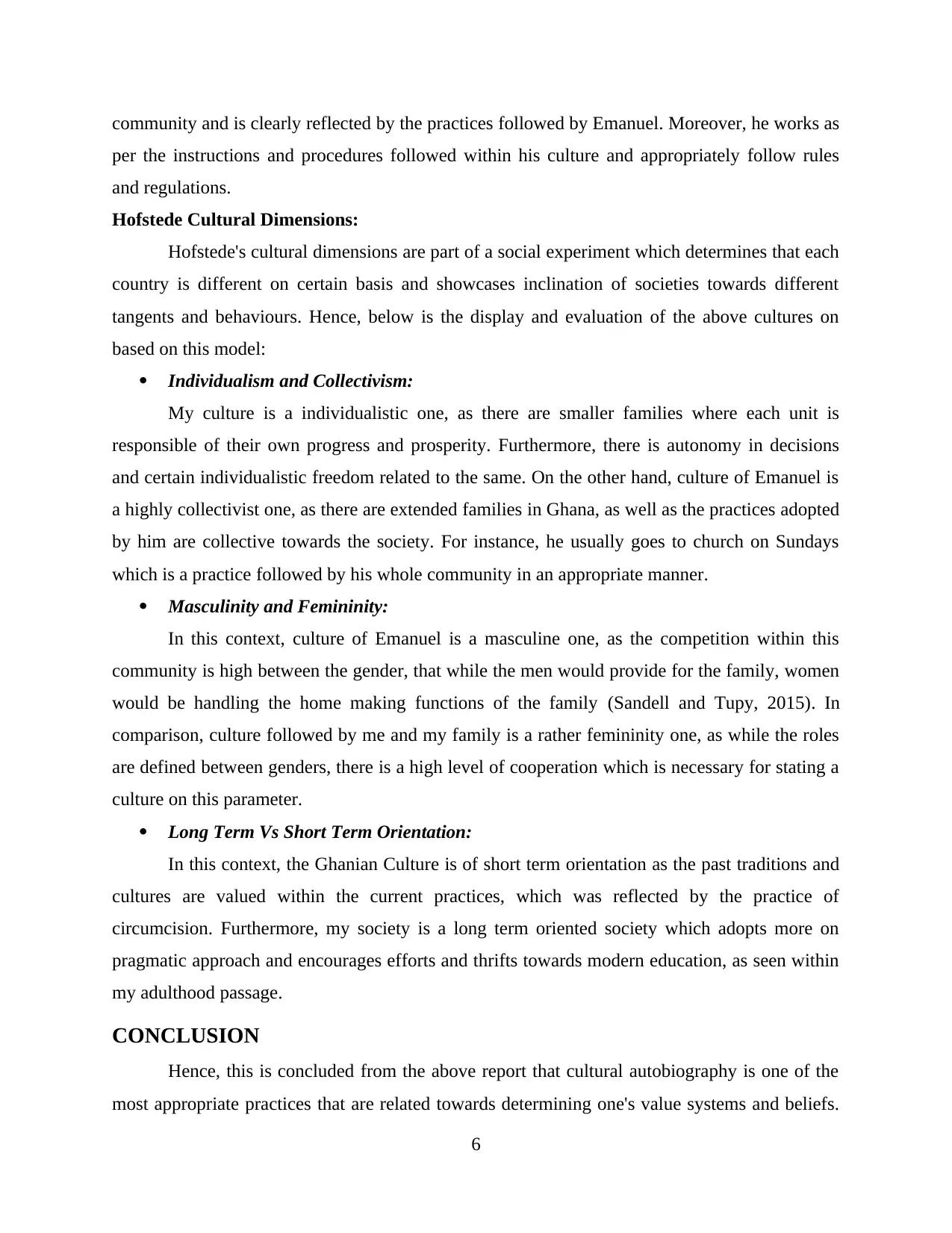
community and is clearly reflected by the practices followed by Emanuel. Moreover, he works as
per the instructions and procedures followed within his culture and appropriately follow rules
and regulations.
Hofstede Cultural Dimensions:
Hofstede's cultural dimensions are part of a social experiment which determines that each
country is different on certain basis and showcases inclination of societies towards different
tangents and behaviours. Hence, below is the display and evaluation of the above cultures on
based on this model:
Individualism and Collectivism:
My culture is a individualistic one, as there are smaller families where each unit is
responsible of their own progress and prosperity. Furthermore, there is autonomy in decisions
and certain individualistic freedom related to the same. On the other hand, culture of Emanuel is
a highly collectivist one, as there are extended families in Ghana, as well as the practices adopted
by him are collective towards the society. For instance, he usually goes to church on Sundays
which is a practice followed by his whole community in an appropriate manner.
Masculinity and Femininity:
In this context, culture of Emanuel is a masculine one, as the competition within this
community is high between the gender, that while the men would provide for the family, women
would be handling the home making functions of the family (Sandell and Tupy, 2015). In
comparison, culture followed by me and my family is a rather femininity one, as while the roles
are defined between genders, there is a high level of cooperation which is necessary for stating a
culture on this parameter.
Long Term Vs Short Term Orientation:
In this context, the Ghanian Culture is of short term orientation as the past traditions and
cultures are valued within the current practices, which was reflected by the practice of
circumcision. Furthermore, my society is a long term oriented society which adopts more on
pragmatic approach and encourages efforts and thrifts towards modern education, as seen within
my adulthood passage.
CONCLUSION
Hence, this is concluded from the above report that cultural autobiography is one of the
most appropriate practices that are related towards determining one's value systems and beliefs.
6
per the instructions and procedures followed within his culture and appropriately follow rules
and regulations.
Hofstede Cultural Dimensions:
Hofstede's cultural dimensions are part of a social experiment which determines that each
country is different on certain basis and showcases inclination of societies towards different
tangents and behaviours. Hence, below is the display and evaluation of the above cultures on
based on this model:
Individualism and Collectivism:
My culture is a individualistic one, as there are smaller families where each unit is
responsible of their own progress and prosperity. Furthermore, there is autonomy in decisions
and certain individualistic freedom related to the same. On the other hand, culture of Emanuel is
a highly collectivist one, as there are extended families in Ghana, as well as the practices adopted
by him are collective towards the society. For instance, he usually goes to church on Sundays
which is a practice followed by his whole community in an appropriate manner.
Masculinity and Femininity:
In this context, culture of Emanuel is a masculine one, as the competition within this
community is high between the gender, that while the men would provide for the family, women
would be handling the home making functions of the family (Sandell and Tupy, 2015). In
comparison, culture followed by me and my family is a rather femininity one, as while the roles
are defined between genders, there is a high level of cooperation which is necessary for stating a
culture on this parameter.
Long Term Vs Short Term Orientation:
In this context, the Ghanian Culture is of short term orientation as the past traditions and
cultures are valued within the current practices, which was reflected by the practice of
circumcision. Furthermore, my society is a long term oriented society which adopts more on
pragmatic approach and encourages efforts and thrifts towards modern education, as seen within
my adulthood passage.
CONCLUSION
Hence, this is concluded from the above report that cultural autobiography is one of the
most appropriate practices that are related towards determining one's value systems and beliefs.
6
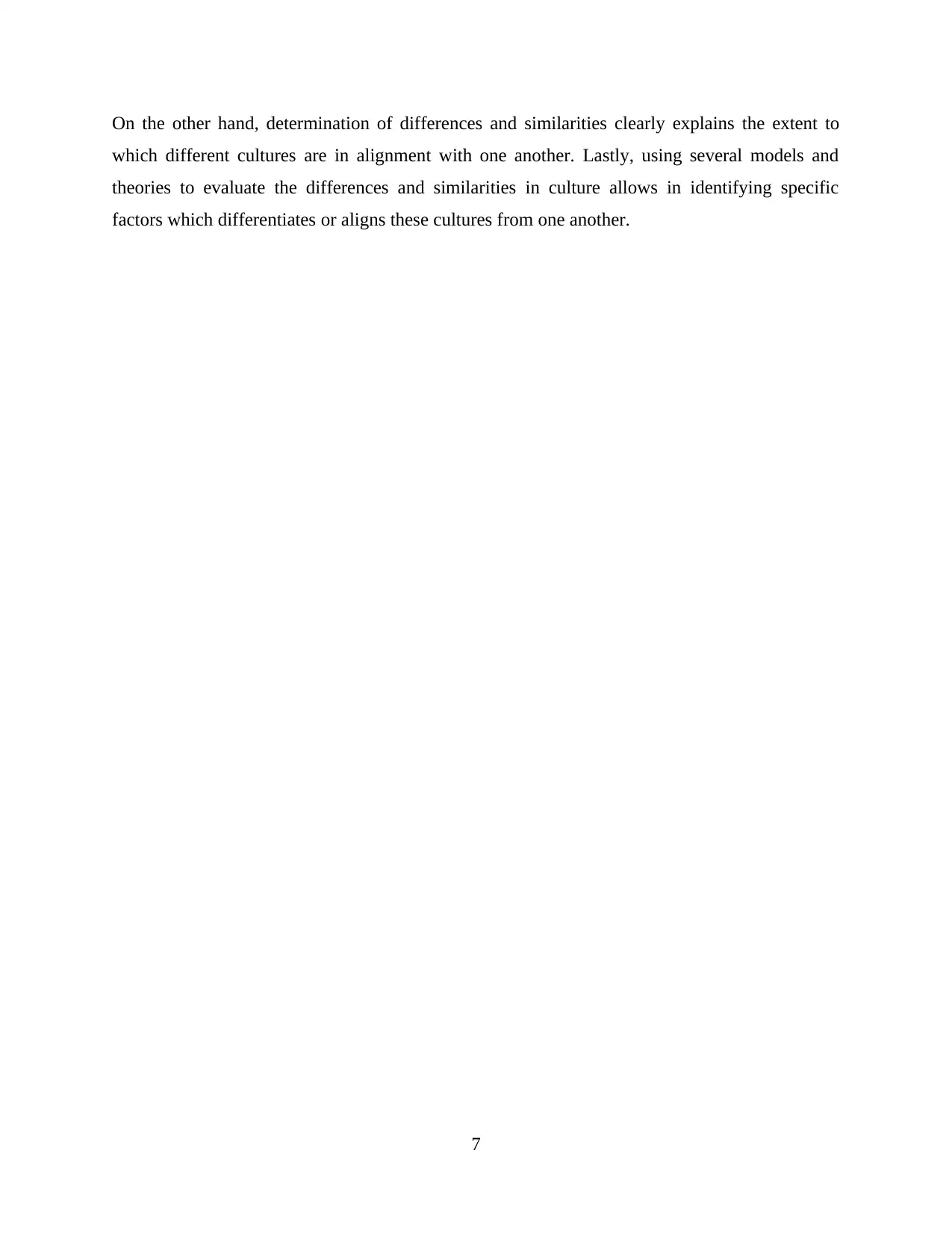
On the other hand, determination of differences and similarities clearly explains the extent to
which different cultures are in alignment with one another. Lastly, using several models and
theories to evaluate the differences and similarities in culture allows in identifying specific
factors which differentiates or aligns these cultures from one another.
7
which different cultures are in alignment with one another. Lastly, using several models and
theories to evaluate the differences and similarities in culture allows in identifying specific
factors which differentiates or aligns these cultures from one another.
7
⊘ This is a preview!⊘
Do you want full access?
Subscribe today to unlock all pages.

Trusted by 1+ million students worldwide
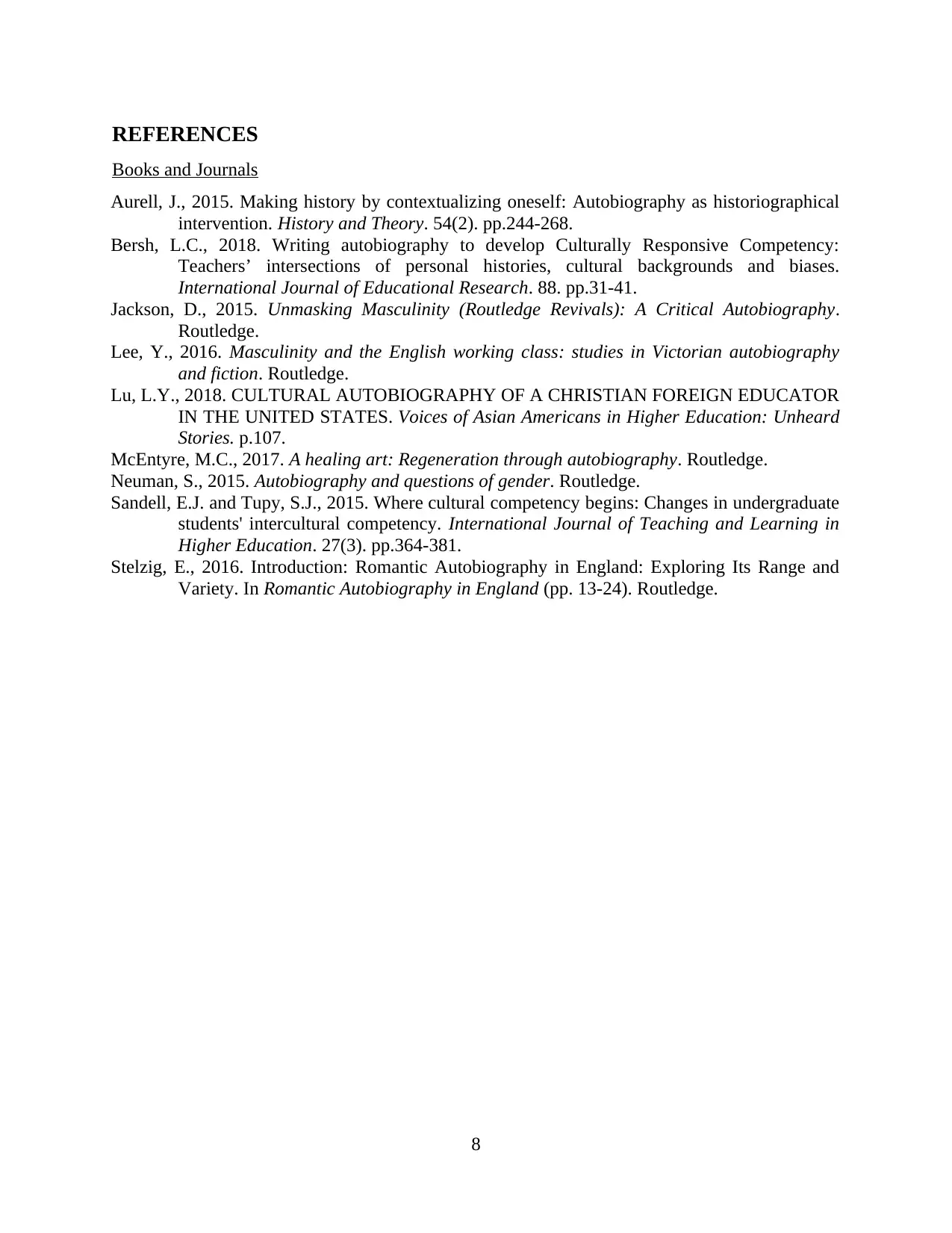
REFERENCES
Books and Journals
Aurell, J., 2015. Making history by contextualizing oneself: Autobiography as historiographical
intervention. History and Theory. 54(2). pp.244-268.
Bersh, L.C., 2018. Writing autobiography to develop Culturally Responsive Competency:
Teachers’ intersections of personal histories, cultural backgrounds and biases.
International Journal of Educational Research. 88. pp.31-41.
Jackson, D., 2015. Unmasking Masculinity (Routledge Revivals): A Critical Autobiography.
Routledge.
Lee, Y., 2016. Masculinity and the English working class: studies in Victorian autobiography
and fiction. Routledge.
Lu, L.Y., 2018. CULTURAL AUTOBIOGRAPHY OF A CHRISTIAN FOREIGN EDUCATOR
IN THE UNITED STATES. Voices of Asian Americans in Higher Education: Unheard
Stories. p.107.
McEntyre, M.C., 2017. A healing art: Regeneration through autobiography. Routledge.
Neuman, S., 2015. Autobiography and questions of gender. Routledge.
Sandell, E.J. and Tupy, S.J., 2015. Where cultural competency begins: Changes in undergraduate
students' intercultural competency. International Journal of Teaching and Learning in
Higher Education. 27(3). pp.364-381.
Stelzig, E., 2016. Introduction: Romantic Autobiography in England: Exploring Its Range and
Variety. In Romantic Autobiography in England (pp. 13-24). Routledge.
8
Books and Journals
Aurell, J., 2015. Making history by contextualizing oneself: Autobiography as historiographical
intervention. History and Theory. 54(2). pp.244-268.
Bersh, L.C., 2018. Writing autobiography to develop Culturally Responsive Competency:
Teachers’ intersections of personal histories, cultural backgrounds and biases.
International Journal of Educational Research. 88. pp.31-41.
Jackson, D., 2015. Unmasking Masculinity (Routledge Revivals): A Critical Autobiography.
Routledge.
Lee, Y., 2016. Masculinity and the English working class: studies in Victorian autobiography
and fiction. Routledge.
Lu, L.Y., 2018. CULTURAL AUTOBIOGRAPHY OF A CHRISTIAN FOREIGN EDUCATOR
IN THE UNITED STATES. Voices of Asian Americans in Higher Education: Unheard
Stories. p.107.
McEntyre, M.C., 2017. A healing art: Regeneration through autobiography. Routledge.
Neuman, S., 2015. Autobiography and questions of gender. Routledge.
Sandell, E.J. and Tupy, S.J., 2015. Where cultural competency begins: Changes in undergraduate
students' intercultural competency. International Journal of Teaching and Learning in
Higher Education. 27(3). pp.364-381.
Stelzig, E., 2016. Introduction: Romantic Autobiography in England: Exploring Its Range and
Variety. In Romantic Autobiography in England (pp. 13-24). Routledge.
8
Paraphrase This Document
Need a fresh take? Get an instant paraphrase of this document with our AI Paraphraser
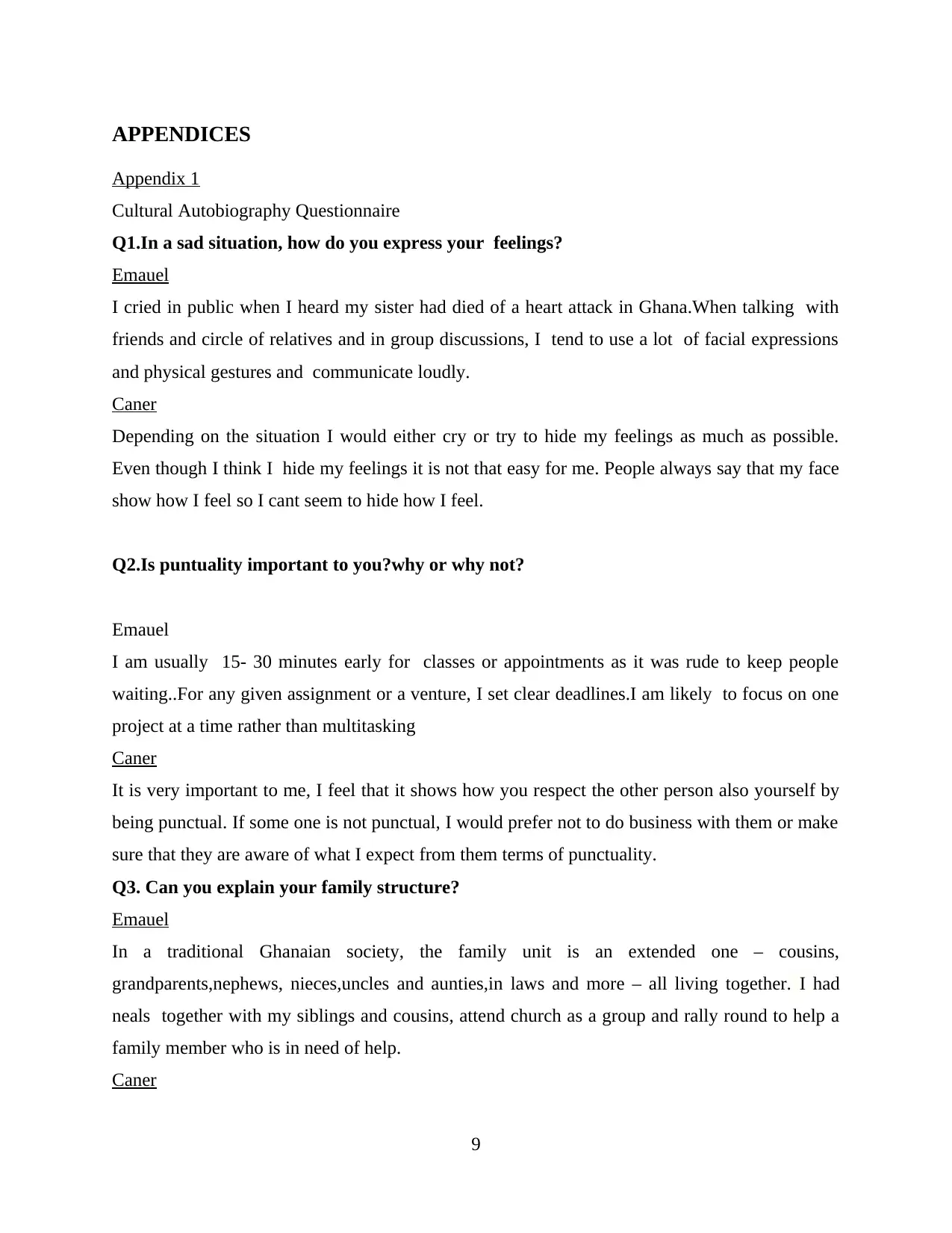
APPENDICES
Appendix 1
Cultural Autobiography Questionnaire
Q1.In a sad situation, how do you express your feelings?
Emauel
I cried in public when I heard my sister had died of a heart attack in Ghana.When talking with
friends and circle of relatives and in group discussions, I tend to use a lot of facial expressions
and physical gestures and communicate loudly.
Caner
Depending on the situation I would either cry or try to hide my feelings as much as possible.
Even though I think I hide my feelings it is not that easy for me. People always say that my face
show how I feel so I cant seem to hide how I feel.
Q2.Is puntuality important to you?why or why not?
Emauel
I am usually 15- 30 minutes early for classes or appointments as it was rude to keep people
waiting..For any given assignment or a venture, I set clear deadlines.I am likely to focus on one
project at a time rather than multitasking
Caner
It is very important to me, I feel that it shows how you respect the other person also yourself by
being punctual. If some one is not punctual, I would prefer not to do business with them or make
sure that they are aware of what I expect from them terms of punctuality.
Q3. Can you explain your family structure?
Emauel
In a traditional Ghanaian society, the family unit is an extended one – cousins,
grandparents,nephews, nieces,uncles and aunties,in laws and more – all living together. I had
neals together with my siblings and cousins, attend church as a group and rally round to help a
family member who is in need of help.
Caner
9
Appendix 1
Cultural Autobiography Questionnaire
Q1.In a sad situation, how do you express your feelings?
Emauel
I cried in public when I heard my sister had died of a heart attack in Ghana.When talking with
friends and circle of relatives and in group discussions, I tend to use a lot of facial expressions
and physical gestures and communicate loudly.
Caner
Depending on the situation I would either cry or try to hide my feelings as much as possible.
Even though I think I hide my feelings it is not that easy for me. People always say that my face
show how I feel so I cant seem to hide how I feel.
Q2.Is puntuality important to you?why or why not?
Emauel
I am usually 15- 30 minutes early for classes or appointments as it was rude to keep people
waiting..For any given assignment or a venture, I set clear deadlines.I am likely to focus on one
project at a time rather than multitasking
Caner
It is very important to me, I feel that it shows how you respect the other person also yourself by
being punctual. If some one is not punctual, I would prefer not to do business with them or make
sure that they are aware of what I expect from them terms of punctuality.
Q3. Can you explain your family structure?
Emauel
In a traditional Ghanaian society, the family unit is an extended one – cousins,
grandparents,nephews, nieces,uncles and aunties,in laws and more – all living together. I had
neals together with my siblings and cousins, attend church as a group and rally round to help a
family member who is in need of help.
Caner
9
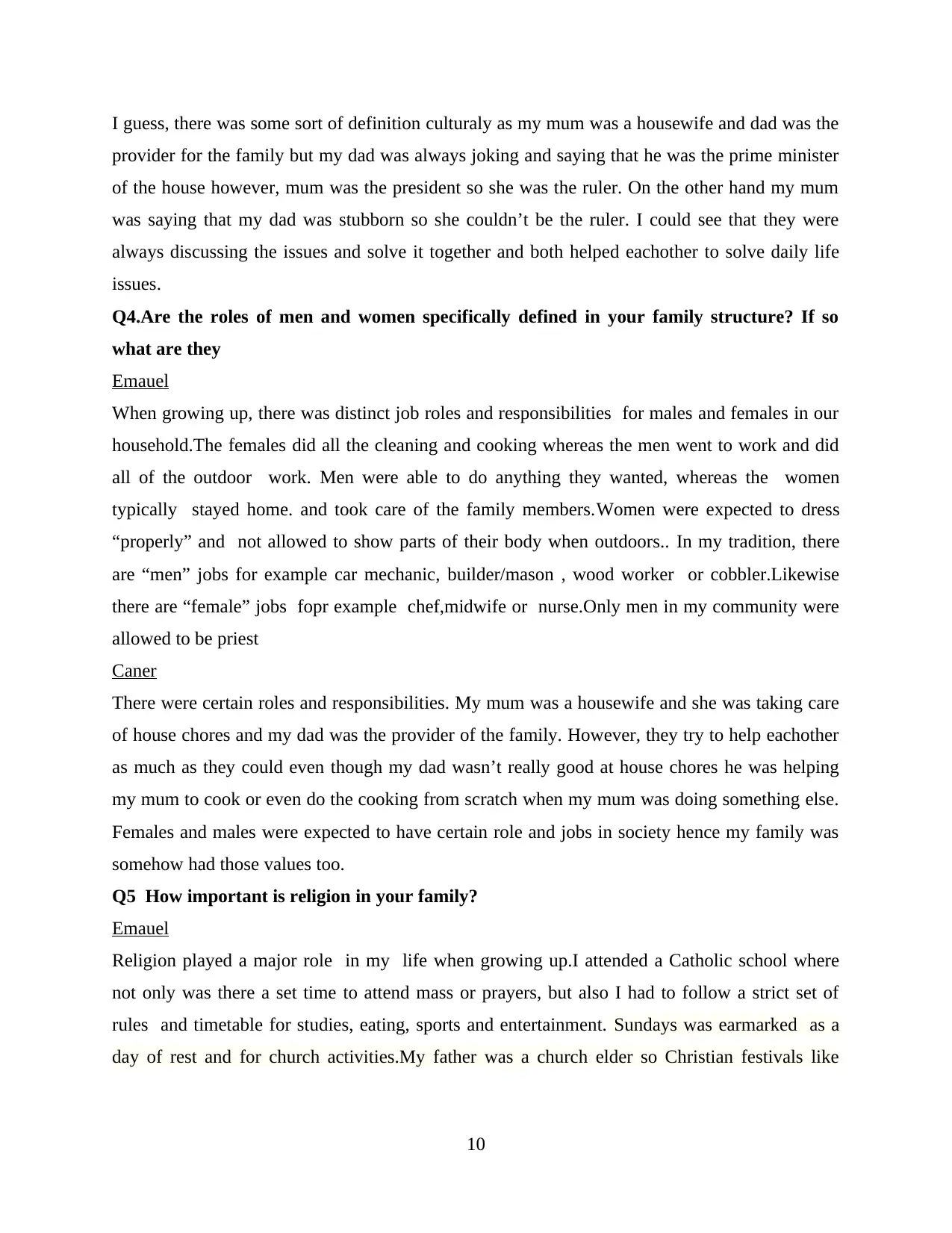
I guess, there was some sort of definition culturaly as my mum was a housewife and dad was the
provider for the family but my dad was always joking and saying that he was the prime minister
of the house however, mum was the president so she was the ruler. On the other hand my mum
was saying that my dad was stubborn so she couldn’t be the ruler. I could see that they were
always discussing the issues and solve it together and both helped eachother to solve daily life
issues.
Q4.Are the roles of men and women specifically defined in your family structure? If so
what are they
Emauel
When growing up, there was distinct job roles and responsibilities for males and females in our
household.The females did all the cleaning and cooking whereas the men went to work and did
all of the outdoor work. Men were able to do anything they wanted, whereas the women
typically stayed home. and took care of the family members.Women were expected to dress
“properly” and not allowed to show parts of their body when outdoors.. In my tradition, there
are “men” jobs for example car mechanic, builder/mason , wood worker or cobbler.Likewise
there are “female” jobs fopr example chef,midwife or nurse.Only men in my community were
allowed to be priest
Caner
There were certain roles and responsibilities. My mum was a housewife and she was taking care
of house chores and my dad was the provider of the family. However, they try to help eachother
as much as they could even though my dad wasn’t really good at house chores he was helping
my mum to cook or even do the cooking from scratch when my mum was doing something else.
Females and males were expected to have certain role and jobs in society hence my family was
somehow had those values too.
Q5 How important is religion in your family?
Emauel
Religion played a major role in my life when growing up.I attended a Catholic school where
not only was there a set time to attend mass or prayers, but also I had to follow a strict set of
rules and timetable for studies, eating, sports and entertainment. Sundays was earmarked as a
day of rest and for church activities.My father was a church elder so Christian festivals like
10
provider for the family but my dad was always joking and saying that he was the prime minister
of the house however, mum was the president so she was the ruler. On the other hand my mum
was saying that my dad was stubborn so she couldn’t be the ruler. I could see that they were
always discussing the issues and solve it together and both helped eachother to solve daily life
issues.
Q4.Are the roles of men and women specifically defined in your family structure? If so
what are they
Emauel
When growing up, there was distinct job roles and responsibilities for males and females in our
household.The females did all the cleaning and cooking whereas the men went to work and did
all of the outdoor work. Men were able to do anything they wanted, whereas the women
typically stayed home. and took care of the family members.Women were expected to dress
“properly” and not allowed to show parts of their body when outdoors.. In my tradition, there
are “men” jobs for example car mechanic, builder/mason , wood worker or cobbler.Likewise
there are “female” jobs fopr example chef,midwife or nurse.Only men in my community were
allowed to be priest
Caner
There were certain roles and responsibilities. My mum was a housewife and she was taking care
of house chores and my dad was the provider of the family. However, they try to help eachother
as much as they could even though my dad wasn’t really good at house chores he was helping
my mum to cook or even do the cooking from scratch when my mum was doing something else.
Females and males were expected to have certain role and jobs in society hence my family was
somehow had those values too.
Q5 How important is religion in your family?
Emauel
Religion played a major role in my life when growing up.I attended a Catholic school where
not only was there a set time to attend mass or prayers, but also I had to follow a strict set of
rules and timetable for studies, eating, sports and entertainment. Sundays was earmarked as a
day of rest and for church activities.My father was a church elder so Christian festivals like
10
⊘ This is a preview!⊘
Do you want full access?
Subscribe today to unlock all pages.

Trusted by 1+ million students worldwide
1 out of 13
Related Documents
Your All-in-One AI-Powered Toolkit for Academic Success.
+13062052269
info@desklib.com
Available 24*7 on WhatsApp / Email
![[object Object]](/_next/static/media/star-bottom.7253800d.svg)
Unlock your academic potential
Copyright © 2020–2025 A2Z Services. All Rights Reserved. Developed and managed by ZUCOL.




